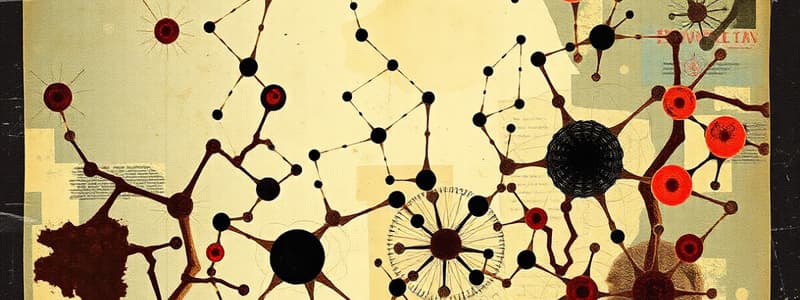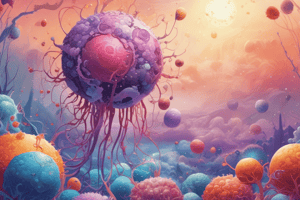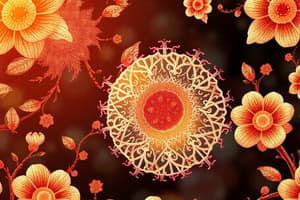Podcast
Questions and Answers
What is the primary purpose of negative selection in B cell development?
What is the primary purpose of negative selection in B cell development?
- To initiate the process of somatic mutation
- To assist in the maturation of all B cells
- To eliminate B cells with high affinity for self antigens (correct)
- To promote the expansion of self-reactive B cells
Which component is essential for the full maturity of B cells and involves a change in RNA coding?
Which component is essential for the full maturity of B cells and involves a change in RNA coding?
- The presence of T cell help
- Expression of membrane-bound IgD (correct)
- Production of high affinity antibodies
- Clonal expansion after antigen stimulation
Which of the following accurately describes the structure of the B cell receptor (BCR)?
Which of the following accurately describes the structure of the B cell receptor (BCR)?
- It has identical N-terminal portions for all isotypes
- It contains two heavy chains and two light chains (correct)
- It is composed solely of disulfide bonds
- It consists of five polypeptide chains
What percentage of B cells produced in the bone marrow daily successfully reach the circulation?
What percentage of B cells produced in the bone marrow daily successfully reach the circulation?
Which statement best describes the role of Igα/Igβ in B cells?
Which statement best describes the role of Igα/Igβ in B cells?
What is the first step that occurs in TCR gene rearrangement?
What is the first step that occurs in TCR gene rearrangement?
Which genes are responsible for enabling the rearrangement of TCR genes?
Which genes are responsible for enabling the rearrangement of TCR genes?
What is the purpose of positive selection in T cell development?
What is the purpose of positive selection in T cell development?
What occurs during negative selection in T cell maturation?
What occurs during negative selection in T cell maturation?
During the rearrangement of the TCR β chain, what segments are randomly joined?
During the rearrangement of the TCR β chain, what segments are randomly joined?
Which statement accurately describes the role of the α-chain gene segment in TCR development?
Which statement accurately describes the role of the α-chain gene segment in TCR development?
What is excised by enzymes like DNA-dependent protein kinase during TCR formation?
What is excised by enzymes like DNA-dependent protein kinase during TCR formation?
What must happen for a T cell to express a functional TCR?
What must happen for a T cell to express a functional TCR?
What is the primary role of the AIRE gene in T cell development?
What is the primary role of the AIRE gene in T cell development?
Which factor is crucial for the differentiation of B lymphocyte progenitor cells into B lymphocyte precursor cells?
Which factor is crucial for the differentiation of B lymphocyte progenitor cells into B lymphocyte precursor cells?
What is the outcome of positive selection in the thymus?
What is the outcome of positive selection in the thymus?
During T cell development, which receptor primarily facilitates the recognition of antigens?
During T cell development, which receptor primarily facilitates the recognition of antigens?
What process is largely responsible for the diversity of T cell receptors (TCRs)?
What process is largely responsible for the diversity of T cell receptors (TCRs)?
Which component is essential for the rearrangement of immunoglobulin (Ig) genes in B cells?
Which component is essential for the rearrangement of immunoglobulin (Ig) genes in B cells?
How does negative selection in the thymus affect T cells?
How does negative selection in the thymus affect T cells?
Which type of T cell emerges from CD4+ T cell differentiation?
Which type of T cell emerges from CD4+ T cell differentiation?
What is a characteristic of immature B cells?
What is a characteristic of immature B cells?
What is the role of integrins and selectins in T cell functions?
What is the role of integrins and selectins in T cell functions?
What role do RAG genes play in T cell development?
What role do RAG genes play in T cell development?
What happens to thymocytes that fail to bind to MHC during positive selection?
What happens to thymocytes that fail to bind to MHC during positive selection?
Which process ensures the elimination of thymocytes that react with self-antigens?
Which process ensures the elimination of thymocytes that react with self-antigens?
What characterizes early stage thymocytes before they express CD4 and CD8?
What characterizes early stage thymocytes before they express CD4 and CD8?
During commitment to CD4+ or CD8+ lineage, what happens to a thymocyte with affinity for MHC I?
During commitment to CD4+ or CD8+ lineage, what happens to a thymocyte with affinity for MHC I?
What percentage of thymocytes typically fail positive selection and die by apoptosis?
What percentage of thymocytes typically fail positive selection and die by apoptosis?
Which type of T cell is committed after passing positive selection and has a high affinity for MHC class II?
Which type of T cell is committed after passing positive selection and has a high affinity for MHC class II?
What is the main role of positive selection in T cell maturation?
What is the main role of positive selection in T cell maturation?
What distinguishes mature T cells that have survived thymic selection?
What distinguishes mature T cells that have survived thymic selection?
What happens to T cells that bind MHC-antigen complexes with high affinity during negative selection?
What happens to T cells that bind MHC-antigen complexes with high affinity during negative selection?
Study Notes
Rearrangement of Germline Gene Segments
- T cells and B cells uniquely possess the ability to rearrange germline gene segments encoding TCR components.
- This process occurs in the thymus for T cells and involves the recombination of gene segments.
- V, J, and D regions are involved in the rearrangement process.
- The DNA of mature B/T cells includes a selection of gene segments from the initial pool.
Development of the TCR
- α and β chains of the TCR are encoded by genes found in segments across different regions of DNA.
- TCR gene rearrangement begins with the β-chain genes in pre-T cells, involving random joining of Dβ and Jβ segments followed by linking with a Vβ segment to form the variable region of a β chain.
- The rearrangement of the α-chain gene segment follows, with Vα and Jα segments joining to create an α-chain variable region, which is then joined to a Cα region segment.
- A fully rearranged β chain is functionally inactive until the α chain has been rearranged.
- RAG1 and RAG2 genes are involved in the rearrangement process.
Activity of RAG1 and RAG2
- Enzymes like DNA-dependent protein kinase contribute to TCR diversity by excising intervening DNA.
Selection of T cells
- T cells must express a functional TCR capable of recognizing MHC–antigen complexes on APCs.
- Selection occurs in two steps: positive and negative selection.
- Positive selection ensures TCR binding to MHC on thymic cortical epithelial cells.
- Negative selection eliminates T cells with high affinity for self-antigens presented by APCs.
- Autoimmune regulator (AIRE) gene allows thymic epithelial cells to express proteins from other tissues.
Major Groups of Receptors on T Cells
- T cells possess various receptors, including antigen receptors (TCR), regulatory receptors, cytokine receptors, transport receptors, antibody receptors, chemokine receptors, complement receptors, and adhesion molecules.
Development of B lymphocytes
- The development of B cells is divided into three stages: maturation, activation, and differentiation.
- Mature, immunocompetent B lymphocytes are generated during maturation.
- Activation occurs upon interaction with specific antigens.
- Differentiation leads to the generation of antibody-producing plasma cells or memory B cells.
- B lymphocyte development occurs primarily in the bone marrow.
B Lymphocyte Maturation
- B cell development starts in fetal life and continues throughout life.
- Development occurs in the yolk sac, fetal liver, and bone marrow.
- After birth, development occurs solely in the bone marrow.
- Differentiation progresses from lymphoid precursor cells to B lymphocyte progenitor cells (Pro-B).
- The presence of IL-7 and bone marrow stromal cells promotes further differentiation.
The B Lymphocyte Receptor (BCR)
- The BCR is composed of heavy (H) and light (L) chains.
- Rearrangement of Ig genes begins with heavy chains followed by light chains.
- Allelic exclusion ensures expression of only one type of light chain (κ or λ).
- Immature B cells express membrane-bound IgM (mIgM) and Igα/Igβ chains, forming the BCR complex.
- RAG1 and RAG2 regulate chain rearrangement.
- Immature B cells are not fully functional.
Positive Selection (T cells)
- A test to determine whether a TCR can bind to MHC I or II on thymic cortical epithelial cells.
- T cells must bind to MHC for successful positive selection.
- Failure to bind results in elimination via apoptosis.
Why Positive Selection?
- Eliminates thymocytes that fail to assemble a TCR or have a useless TCR.
- Commits T cells to either a CD4+ or CD8+ lineage.
Negative Selection (T cells)
- Eliminates T cells with high affinity for self-antigens presented by APCs.
- Eliminates most thymocytes that react with self-antigens in the thymus.
- Early stage thymocytes lack CD4 and CD8, but express them once αβ TCR is expressed.
- Mature T cells are single positive (express CD4 or CD8 only).
Commitment to CD4+ or CD8+ T cells
- TCR affinity determines the expression of CD4 or CD8.
- If the TCR binds MHC I, CD4 is turned off and CD8 is expressed.
- If the TCR binds MHC II, CD8 is turned off and CD4 is expressed.
Selection of T cells (cont.)
- T cells that survive selection leave the thymus via blood.
- CD8+ T cells become cytotoxic T cells.
- CD4+ T cells become helper T cells (differentiate into Th1, Th2, Th17 etc.).
Stimulation through the BCR
- At this stage, BCR stimulation can lead to cell death or anergy (lack of response).
Full Maturity of B cells
- Achieved after membrane-bound IgD is expressed.
- Requires a change in RNA coding to allow expression of both μ and δ heavy chains (IgM and IgD).
Checkpoints of B cell development
- Numerous checkpoints ensure proper B cell development and eliminate cells that fail to meet criteria.
Negative Selection/Clonal Deletion (B cells)
- Of the 5 x 10^10 B cells produced daily, only 10% reach circulation.
- Eliminates B cells exhibiting high affinity for self-antigens.
Mature B Cells
- Leave the bone marrow and reach the periphery for activation and differentiation into plasma cells.
The B cell receptor (BCR)
- Consists of four polypeptide chains: two identical H chains and two identical L chains.
- Bound by disulfide bonds.
- N-terminal portions of H and L chains are highly variable.
- Igα/Igβ are signaling molecules.
Other receptors on B cells
- B cells possess multiple receptors for various functions.
Location of lymphocytes in the body
- Lymphocytes are distributed throughout the body, with varying populations in different organs and tissues.
Lymphocyte populations in different animal species
- Lymphocyte populations vary across different animal species.
Studying That Suits You
Use AI to generate personalized quizzes and flashcards to suit your learning preferences.
Related Documents
Description
This quiz explores the processes of T cell and B cell development, focusing on the rearrangement of germline gene segments that encode TCR components. Learn about the specific regions involved, the processes that occur in the thymus, and the formation of the TCR's variable regions. Test your understanding of this crucial aspect of immunology.



